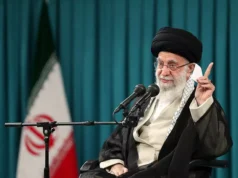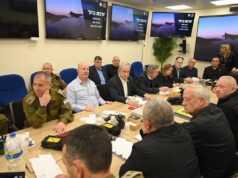
The Iron Dome missile defense system fires to intercept incoming missiles from Gaza in the Israeli port town of Ashdod on November 15, 2012. |
The United States defense establishment is a major partner in Israel’s strategic balance and a pillar of its defensive shield. And Israel has contributed to American tactics and weapons systems. At the same time, no American soldier has ever fought in a battle in which Israel was fighting with its Arab neighbors, nor is that expected to happen in the future. The statement that the U.S. is committed to Israel’s security has been repeatedly made by the U.S. President and key U.S. political and military leaders. America’s commitment to Israel’s Qualitative Military Edge (QME) has been reiterated and enhanced by presidents and congresses of both political parties, even as the United States replaced the Soviet Union as the source of much of the Arab world’s weaponry.
During the first twenty years of its existence as a state, however, Israel relied on European military hardware and security cooperation. In 1956 and 1967, Israel went to battle equipped mostly with French arms. The Israeli military’s overwhelming success in 1967 was a watershed in terms of Israel’s overall relation with the United States.
The Legacy of 1967
The 1967 Six Day War has been properly understood as a defeat for the Soviet Union, with which Syria and Egypt had aligned themselves. The armies of these two Israeli neighbors were heavily armed with Russian-made weapons at the height of the Soviet-American Cold War, which had a significant impact on U.S. strategy in the Middle East and the Mediterranean. The political and military outcomes of the war therefore transformed Israel into a central player in the context of the bi-polar competition. The resulting emergence of an intensive geo-strategic dialogue between Jerusalem and Washington translated into closer and stronger military relations. The arms embargo that France imposed in 1967, followed by the one imposed by Great Britain in 1973 only accelerated Israel’s shift to a U.S. weapons-based army.
Following the 1973 Yom Kippur War, a U.S. military delegation that included General Donn Starry, later Commanding General of the U.S. Readiness Command, studied Israeli battle tactics, particularly in the Sinai Desert. The resulting reports and observations were instrumental in creating the U.S. Air Land Battle Doctrine that proved exceptionally successful in the 1991 Gulf War.
The span of the U.S.-Israel strategic relationship, in which the military-to-military relations are just one piece of a larger puzzle, is difficult to describe. The United States-Israel Enhanced Security Cooperation Act (P.L. 112-150) that President Obama signed into law on 27 July 2012 provides a glimpse. It is a short but impressive list of initiatives to enhance political, military and intelligence cooperation activities between the two partners.
Military-to-military relations between the U.S. and Israel have benefitted from a unique set of circumstances in which the two find themselves. They use the same hardware and their armies and soldiers are continually involved in battle. In some cases, they find themselves operating in similar physical and climatic circumstances. The level of research and development both in the area of hardware and training, as well as in drawing lessons-learned from active combat, allows the two armies to mutually benefit from these experiences and to increase interoperability between the two armies.
Cooperation in Rocket and Missile Defense
Joint military cooperation in the area of rocket and missile defense serves as the most well known, and most recent example. The success of the Iron Dome missile defense system was the result of a joint effort in development, backed by critical U.S. military assistance that amounted to $275 million for the system in FY2012. Iron Dome is only part of the joint research and development of missile defense systems, which also includes the long-range Arrow anti-missile defense system and the short-range David’s Sling system.
The U.S. stands to benefit immensely from Israel’s rocket defense R&D efforts. Both the Iron Dome (operational) and David’s Sling (soon to become operational) systems offer capabilities that no other country in the world has. The Israeli firm Rafael developed the Iron Dome system, and has since partnered with Raytheon to produce it for U.S. allies, and perhaps for the U.S. military. Given Iron Dome’s successful track record to date, there have been requests on the U.S. side for co-production or technology sharing. Similarly, Raytheon and Rafael have collaborated in the development of David’s Sling in order to meet U.S. and Israeli operational requirements and it may also be procured by the U.S. military.
Looking forward, U.S.-Israel rocket and missile defense cooperation is likely to deepen further through continued U.S. support and engagement in the development of the Arrow III system. U.S. funding of the Arrow III exo-atmospheric interceptor, to be fielded in 2015, will provide Washington with key insights into the development of a system that, according to senior U.S. Missile Defense Agency (MDA) officials, “will be more capable than anything the United States has on the drawing board,” as reported in the Eisenstadt and Pollock study, Asset Test: How the U.S. Benefits from its Alliance with Israel.
While this sort of cooperation relates to joint development and production, the U.S. and Israel have additionally held joint missile defense exercises. The largest and most recent, Austere Challenge 12, was held in October-November 2012, involving 3,500 U.S. and 1,000 Israeli personnel.
By Air…
Air Force cooperation has been one of the most advanced areas of cooperation due to the Israeli Air Force’s total reliance on U.S. hardware and the Israeli contributions to the different systems and joint training and exercises. Recent talks between the heads of the U.S. Department of Defense and the Israeli Ministry of Defense centered on Israel’s share of the production of the F-35 Joint Strike Fighter and on the modifications to be made to adjust the system to Israeli requests.
Most recently, in January of this year, the U.S. 86th Airlift Wing and 435th Contingency Response Group conducted joint training exercises in Israel.
…And By Sea
The presence of the U.S. Sixth Fleet in the Mediterranean enables close cooperation between the two states’ naval and other forces. The two forces regularly conduct joint exercises. Reliant Mermaid, which took place in August 2012, was a search and rescue exercise that included the use of live ammunition. The U.S. deployed its most advanced vessels during the exercise, such as the Aegis-class destroyers.
Military Intelligence Sharing
U.S.-Israel military intelligence cooperation is part of a wider exchange between the two states and is based on the sharing of instruments and information-gathering resources employed by the two in the Middle East region. The close proximity of Israel, the ongoing confrontation with regional terror groups with links to terror organizations from outside the region, together with the importation of weapons systems from sources hostile to both Israel and the United States, makes this intelligence sharing essential for success. Military intelligence cooperation is, and will be, the basis for the intense dialogue that the two states hold concerning the Iranian nuclear effort and nuclear proliferation in the Middle East.
The Arab upheaval and its implications reach beyond the military realm, but the uncertainty and instability it created have military implications nonetheless. Here again, the intelligence-gathering and sharing will be essential for the understanding of the events and processes, and for the calibration of the partners’ respective responses. Cooperation in this domain, therefore, has wider significance than just the military.
A Strong Web of Relations
Developing and using the same military hardware systems, sharing lessons learned from previous combat experience, and developing novel concepts and joint exercises, create a wide web of military-to-military relationships between the U.S. and Israel.
The thousands of Israeli and American soldiers who come together at military schools, training facilities, joint exercises, and military industrial plants, create a human bridge. They translate into reality—on a daily basis—the concept of the strategic alliance and the commitment that comes from a statement or a Bill passed by Congress. It is an invaluable contribution to Israel’s long-term security.
Military-to-military cooperation is an important layer in Israel’s defensive shield, beyond whatever news items about certain joint exercises may communicate. These relations reduce the heavy burden entailed in defending Israel. The recent military confrontations in Lebanon 2006, and in Gaza 2008-2009 and 2012 are reminders of the changing nature of the warfare in which Israel finds itself.
Instead of facing conventional armies, Israel is now confronted by a combination of terror and rocketry capabilities of sub-state adversaries, which can be almost instantly resupplied. The Iranian threat of both conventional and potentially non-conventional weapons adds a new dimension.
Israel’s strategic cooperation with the U.S., and particularly its military-to-military relations, are therefore a vital part of Israel’s defense.
Oded Eran is a Senior Researcher at the Institute for National Security Studies, Tel Aviv, and he served twice at the Embassy of Israel in Washington, DC.





